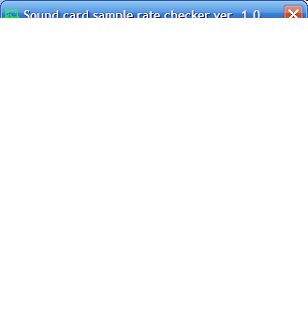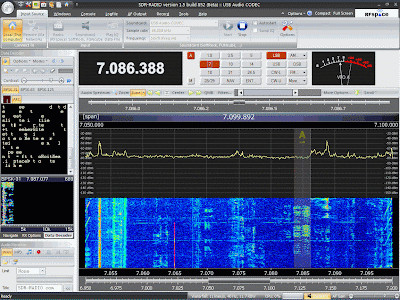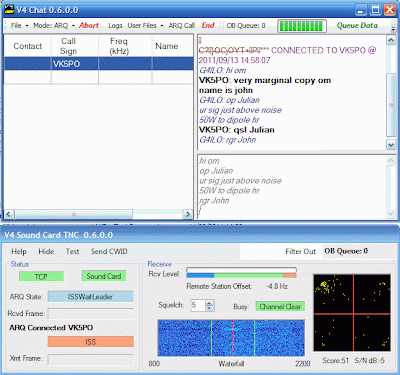Posts Tagged ‘Digimodes’
 Wide boys
Wide boys
What’s the point of PSK125? I just finished a session running PSK31 on 15m (which was really lively, by the way) when I thought I’d just check 10m to see if anything was going on up there. I soon found that there wasn’t much. The waterfall was devoid of traces, apart from a weak, wide, nebulous trace which proved to be PSK125. PY2DN was calling CQ, but try as I might he couldn’t decode me.
It appeared that he was making some QSOs, presumably with people enjoying better 10m propagation than I had. PY2DN’s signal was far from perfect copy. Most times he transmitted I received mostly garbage. But I’m sure there was enough energy in the transmission to produce solid copy had he been using PSK31.
I guess the point of PSK125 is speed. PY2DN’s CQ and my reply both lasted about two seconds. But what’s the hurry? Not only can I not type that fast, I can’t even click macro buttons that fast. So the time saved is for nothing. I accept there is a role for PSK63 in contests, when speed matters, but only when signals are strong enough to provide good copy. PSK125 is a step too far. It spreads the energy too thinly.
I’ve tried loads of new digital modes but I keep on coming back to good old PSK31. I find it more satisfying in the long run. There’s tons of activity from heaps of different locations. You can often find a PSK31 signal when the CW and SSB band segments are dead. PSK31 is a real QSO mode where you can actually converse with somebody and exchange information with them. And you don’t need to run a kilowatt to a huge tribander to be successful. I was calling CQ on 15m with 40w to my attic dipole and I felt like a big gun: I was getting replies, including DX replies, to every other call.
I think PSK31 has earned its place alongside CW and SSB as one of the staple modes of amateur radio. Other modes are just for temporary amusement.
 A JT65-HF update
A JT65-HF update
Due to the health issues of the developer Joe Large W6CQZ it has been some time since there was a new version of the popular JT65-HF application. So I was interested to receive an email from Erwin, DK5EW, telling me about an enhanced version of JT65-HF made by Matthias DL3VCO called JT65-HF-Comfort.
 |
| JT65-HF as enhanced by Matthias, DL3VCO |
Matthias has not made an add-on to JT65-HF in the style of programs like JT-Alert. Instead he has made changes to the actual JT65-HF source code. I was particularly pleased to see that the enhanced version retains compatibility with the popular add-on JT-Alert by Laurie, VK5AMA. When I tried recompiling the JT65-HF source code myself the new version did not work with Laurie’s program, which I regard as an essential aid to JT65A operating. (In fact I have cheekily asked VK5AMA if he would consider making a version of JT-Alert that works with K1JT’s WSJT-X program!)
I have not spent much time with JT65-HF-Comfort as my interest at the moment is directed towards the new JT9 mode, but you can see from the screenshot that one of the improvements DL3VCO has made is to display the callsign above each trace on the waterfall. He has also added a new Statistics menu which displays the number of contacts you have made per DXCC entity per band. I couldn’t show you that as I use KComm for logging so my log is not in a format that JT65-HF-Comfort can read. You can find a Google-translated version of the JT65-HF-Comfort information here.
If you are interested in trying JT65-HF-Comfort then you can download a setup program (a modified version of W6CQZ’s installer) to install the updated version. I shall certainly try using it the next time I do some JT65A operation.
 An interesting discovery about sound cards
An interesting discovery about sound cards
 |
| CheckSR result at 48kHz with internal sound card |
I have several radios connected to my shack PC. For the audio interfacing I have several sound cards or sound devices since most of them are not internal cards but use USB ports. I wanted to make sure the rig I mostly use for digimodes used the best sound card I had so I thought I would do some tests.
Some people believe it’s better to use a high end sound card for radio work. I don’t think there is any benefit for HF use as the noise level will be much higher than even the poorest sound card. There is no advantage to using a device capable of more than 48kHz sample rate unless you are using SDR software and need the extra bandwidth.
The one factor that can really made a difference is the accuracy of the sample rate. Most digimode software uses either 11025Hz or 48000Hz. There is no theoretical advantage to using a faster than 11025Hz rate for terrestrial digimodes. A 48kHz sample rate should not give any benefit and will need more CPU cycles to transfer and process the extra samples.
Sample rate accuracy is important because it affects both the pitch of playback and the data rate. It’s like playing an LP at the wrong speed. If you play a 33rpm LP at 45rpm the music is played at a higher pitch and a faster tempo. If played at a lower speed the sound is lower pitched and slower. This is analogous to what happens if the sample rate of your sound card is not exactly what your digimode software expects it to be.
I tested a number of sound devices using CheckSR.exe. This is a utility that is distributed with the MixW digimode software, but you can probably find it on its own if you Google it. To use it you simply select sound devices for input and output and set the sample rate you wish to test. You then run it until the measured sample rate settles on a stable figure.
I tested the Realtek sound cards built into my shack PC (HP) and a laptop (Dell) using both 11025Hz and 48000Hz sample rates. Both sound cards were as close to the specified sample rate as makes no difference.
 |
| CheckSR result at 11025Hz with USB device |
I then tested a number of USB devices ranging from a $1 audio ‘dongle’ to a $10 model with surround sound and SP-DIF inputs and outputs. The drivers for these devices had names like ‘USB sound device’, ‘Generic USB sound device’ and ‘USB headphone set’. These devices were also close to spot-on at 48000Hz.
But at 11025Hz every single USB device had a measured sample rate of 11100Hz – 1% faster than specified. This would make a 1kHz audio tone play at 1010Hz, whilst a 1200baud APRS packet would be transmitted at a rate of 1212baud. This error is more than enough to prevent decoding of an FSK packet signal. Other digimodes are also subject to sample rate errors. If you have ever seen a PSK or Olivia signal that is strong and clear yet decodes as garbage, an incorrect sample rate (at one end or the other) is the reason.
I was surprised that the sample rate error at 11025Hz was consistent across all USB device samples. This suggests to me that the measured rate of 11100Hz is a factor of the drivers for these devices which may not run at the speed you select but instead resample down from a native speed of 48kHz. It would be interesting to see the results of running CheckSR on some branded USB devices or SignaLink USB interfaces that have their own drivers.
I ran some tests on USB devices at other sample rates. There was no consistency. At 8000Hz the measured rate was fast by a significant amount, but 16000Hz it was slower.
The results suggest that USB audio devices are only as good as internal sound cards if a 48000Hz sample rate is used. The use of lower sample rates with USB devices should be avoided.
 Have fun on digimodes and win an antenna analyzer
Have fun on digimodes and win an antenna analyzer
The Annual Digifest will be held on the first full weekend of June (2012 dates are June 2nd and 3rd ). This will be Digifest’s 5th year. Its popularity is growing with more than 200 logs received last year.
A peculiarity of this Contest is the great variety of different categories of participants in five digital modes: RTTY 75, BPSK 63, MFSK 16, HELLSCHREIBERand OLIVIA. The points calculation is based on the distance between the stations.
The contest consists of 3 convenient periods (8 hours each) during the weekend. To add more excitement those who like competing in real time will be able to see their results on a server.
There are lots of nice prizes, mostly RigExpert AA-230 and AA-30 Antenna Analyzers and RigExpert USB Interfaces. All prizes sponsored by RigExpert Ukraine Ltd.
As the number of the participants is relatively small and the most populated competing area is Europe, stations from NA, SA, Africa, Asia and Australia are at a great advantage. Last year those stations were the most prize winners. To support growing participation from Europe the sponsors have doubled the prizes so separate main prizes are now offered both for Europe and the rest of the world.
For those won’t be able to win a main prize there will be a lot of small gifts like T-shirts and paper awards. All the prizes will be mailed to participants’ home addresses. The results are usually available just 2 weeks after the end of the Contest, So, lets meet on the first weekend of June and have fun!
Complete rules can be found at http://www.mixw.net/misc/DigiFest/index.html and http://www.rigexpert.com/index?s=main&f=digifest
 Operatic debut
Operatic debut
Nothing to do with Verdi or Rossini, nor the web browser of the same name. OPERA is a new weak signal digital mode that has been developed for use on the amateur LF (500kHz) and VLF (136kHz) bands.
Information about it seems to be a bit hard to come by, but there is an OPERA Yahoo group from where I presume you can download the latest version of the software. I managed to find a copy and was surprised at the sophistication of the program. It already has working CAT support for many transceivers including my Elecraft K2 and K3. It also has a built-in chat system showing reported signals from other users.
Although the new mode is apparently the invention of Graham, G0NBD, the program has been written by Jose Alberto Ros, EA5HVK, author of the ROS digital mode, and there are clear similarities in the user interface. The program supports all amateur bands from VLF to 6m but currently you can only select the frequencies 136kHz and 500kHz.
There are actually two OPERA modes, one of which is claimed to be even better (i.e. work with even weaker signals) than the WSPR mode. What is particularly interesting about OPERA though is that it does not need to use a sound card to send a transmission. Although the sound card is an option – and a convenient one for users already set up for data modes – OPERA actually (if I understand correctly) uses on/off keying, in other words CW (though not Morse code.) This offers the potential for long distance contacts to be made using ultra-simple QRPP (very low power) transmitters designed for QRP CW use – though I imagine that success depends on use of a very narrow bandwidth so you might need to pay more attention to transmitter stability than you would need for Morse code.) If the digital encoding scheme is published then it would also be simple to build microcontroller based beacon transmitters.
As I am not equipped to operate on the 500kHz or 136kHz bands I have been unable to try OPERA out on the air myself. But it certainly looks an interesting mode, especially if it is opened up to allow use on the HF bands where it could be used as an alternative to WSPR and QRSS CW modes.
 SDR Radio
SDR Radio
An early Christmas present to myself is this SDR-4 HF receiver from Cross Country Wireless. Actually, it wasn’t intended to be a Christmas present. I decided to get one a couple of months ago when I first found out about it.
I think the SDR-4 is the lowest cost ready built HF bands software defined radio on the market (£150 or about $250 US). Unless you know different, of course. However it seems that a lot of other people thought so too, as there is a waiting list – people are ordering them faster than the designer Chris G4HYG can make them!
The SDR-4 works with the usual free SDR applications. But it also works with the free version of Simon Brown HB9DRV’s SDR-Radio.com application. This is the best SDR software by a mile, though due to all the treatment and medication I am receiving for my brain tumour my mind is a bit slow at the moment and I find figuring out how to do what I want with it a bit challenging.
As you might expect from the author of Ham Radio Deluxe, SDR-Radio.com has built-in support for decoding digital modes. Unfortunately I haven’t managed to work out yet how to get the digital decoder waterfall to be a reasonable size: At the moment it’s a small window on the left hand side which is trying to display 15kHz worth of spectrum and although I’m hearing PSK31 I can’t find a trace to click on! I’m also still trying to discover if there is a PSK Browser in the program that sends reports to the PSK Reporter reverse beacon site. Hopefully someone will enlighten me.
I’m sure I’ll be writing more about the SDR-4 receiver and SDR-Radio.com in due course, but in the meantime if you want more information or to ask questions about the receiver there is a Cross Country Wireless Yahoo! group. You can even try an SDR-4 out over the Internet if you follow the instructions posted by Chris. I did and it worked perfectly – and it was so nice to hear the amateur bands without the awful frying noise I have to endure here.
Yahoo! is also the place to go for information and support of SDR-Radio.com (the software.) I look forward to seeing some comments and experiences of any of my readers who are tempted into trying this software defined radio.
 VK5 with V4
VK5 with V4
Looking for something to pique my interest enough to overcome my lethargy I decided to have another look at the V4 Chat digital mode. I tried it first at the end of last year and made one contact with it, but the alpha software was a bit flaky, then the developer Rick KN6KB had a bereavement and nothing happened for a while so I forgot all about it.
What attracted my interest was discovering that the ARQ mode had now been implemented. V4 Chat supports two conversation modes: Forward Error Correction (FEC) in which the data is sent with a lot of checks and redundancy so many receiving errors can be corrected but you have one chance of getting it correctly, and Automatic Repeat reQuest (ARQ) in which the receiver can request a repeat if a transmission is received with errors. Using ARQ a receiver can repeatedly request a repeat (up to a limit) so even if conditions are marginal a QSO is possible as long as propagation is adequate for short periods of time. Under the same conditions conventional (non ARQ) digital modes would print so much garbage that a contact would not be possible. People who own expensive SCS modems like to boast about how Pactor gets through under difficult conditions but V4 ARQ offers the same kind of performance and requires only your PC and a bit of open source donationware.
I re-subscribed to the V4Protocol Yahoo Group (which is where you can get the software from), downloaded and installed the latest version. Then I set my K3 to 14.073MHz (which is the 20m “calling frequency” for experimental narrow data modes) and waited. After a while I heard the sound of V4 ARQ bursts, and found that VK5PO was in QSO. I saw him disconnect from the other station and sent a CQ. He then connected with me and we had (just about) a QSO.
Signals were marginal both ways and I had to crank the K3 up to 50W to help John copy me but over about 10 minutes names and signal reports were exchanged. One of the nice things about the ARQ mode is that when the text prints up you know the other station has received it error free.
OK, it wasn’t much of a chat, but ignoring WSPR spots I have only ever made one contact with Australia before and that was using JT65A which is not a keyboard chat mode. I was pretty chuffed to exchange words with a ham 16,000km away using my stealth radio station!
I think I’ll be spending a lot more time trying out V4 Chat digital mode and I hope you will too because the more people use it the more contacts we can all make. The V4 signal is 200Hz wide so if 14.073 (or 21.073) is busy move up in 250Hz increments to avoid QRMing someone else’s QSO.

















